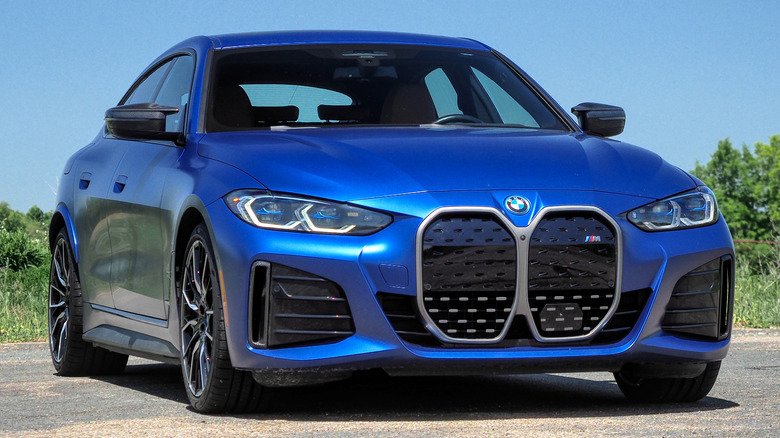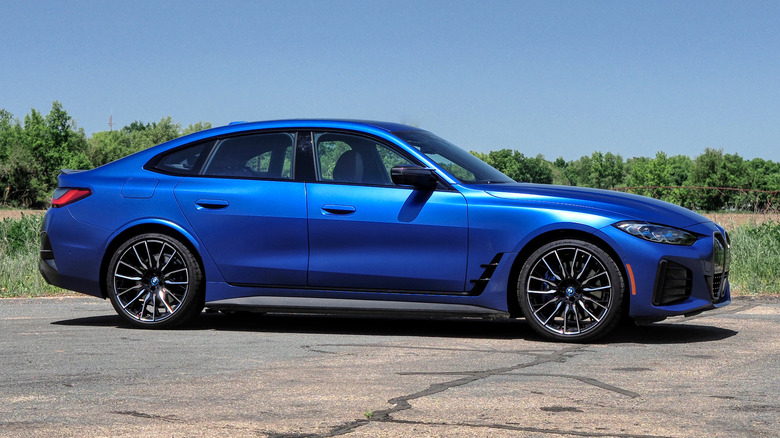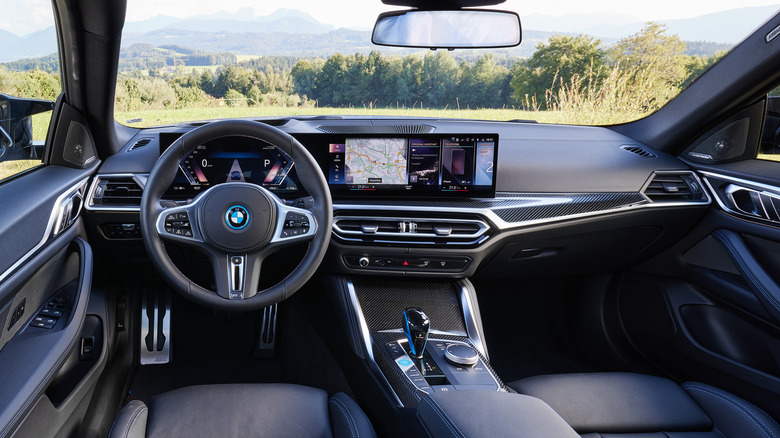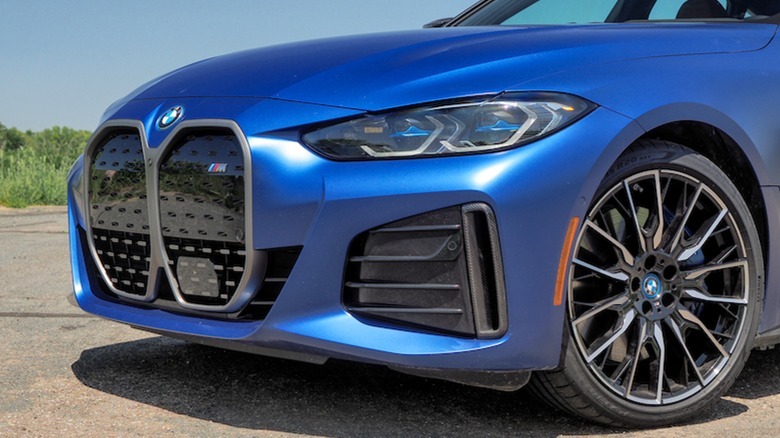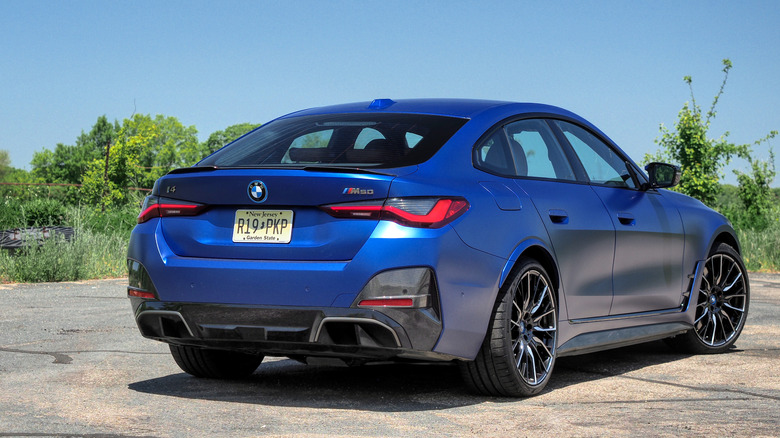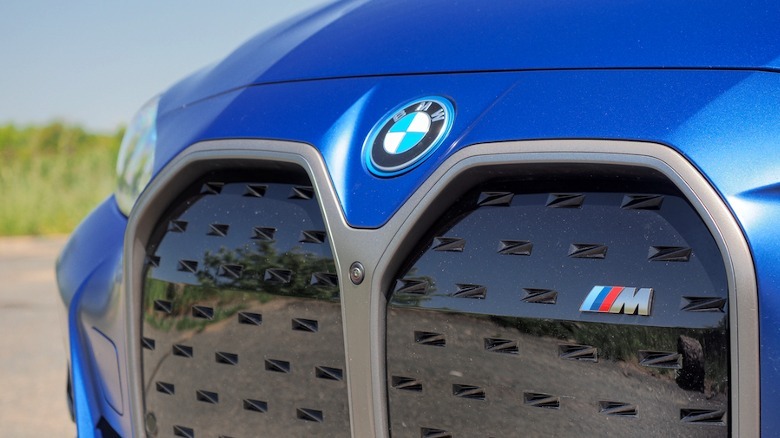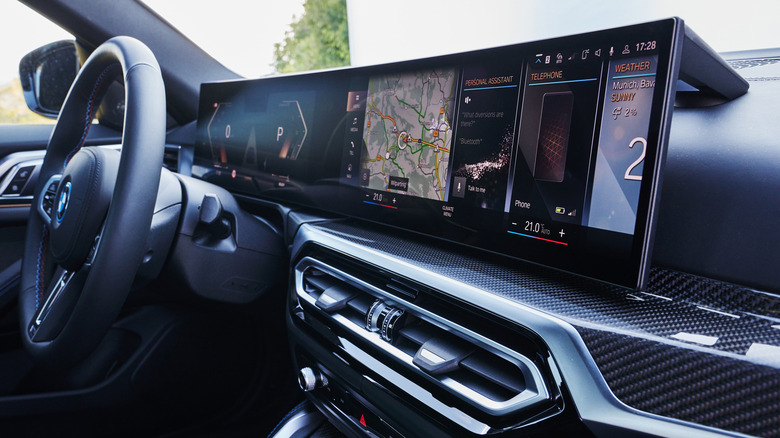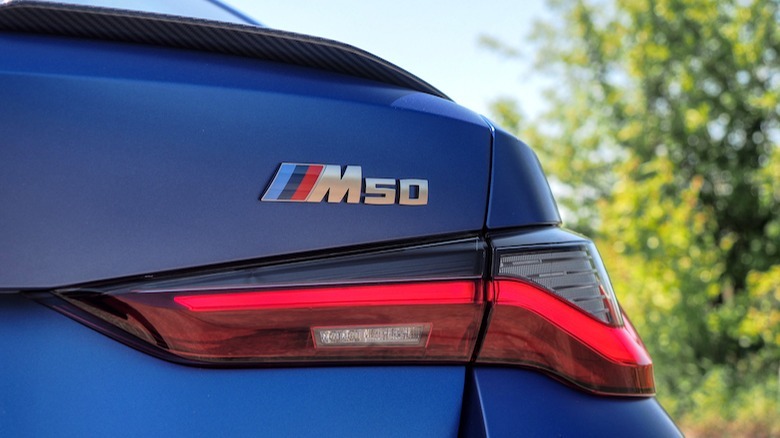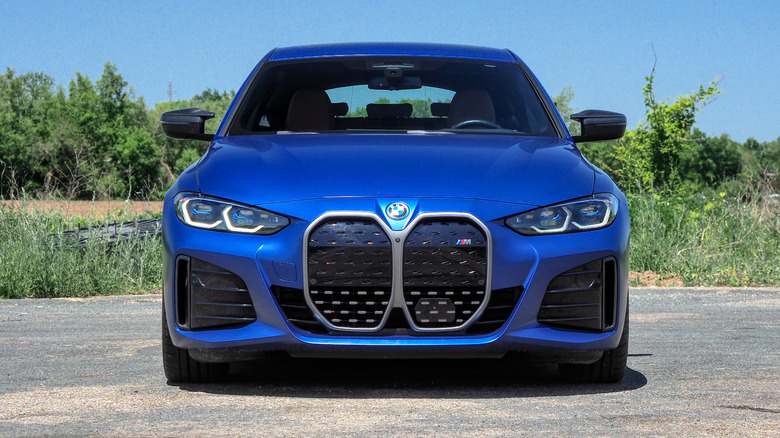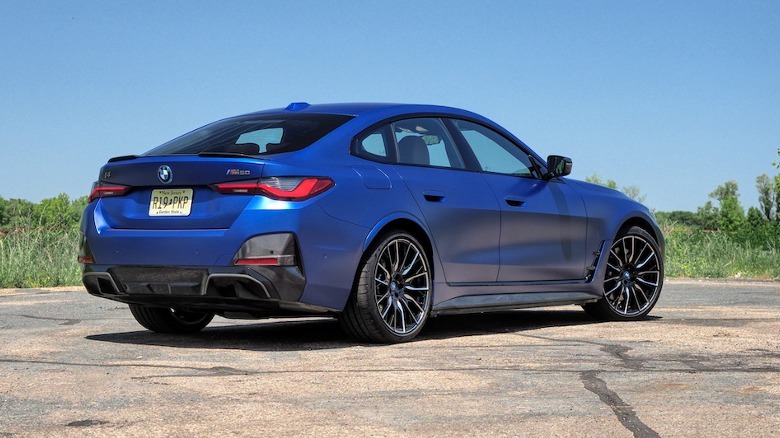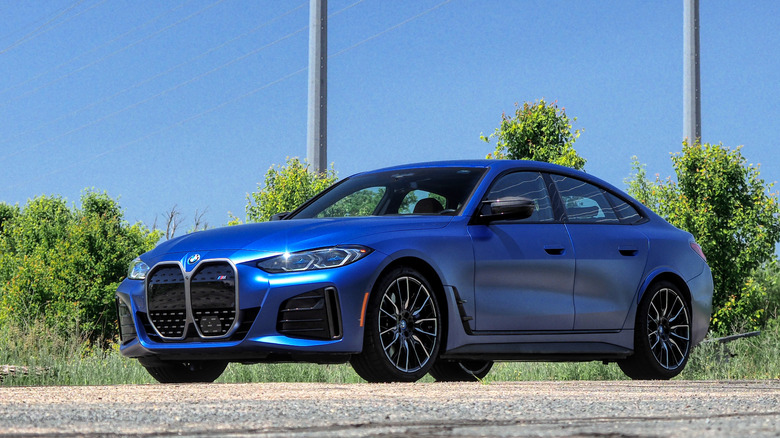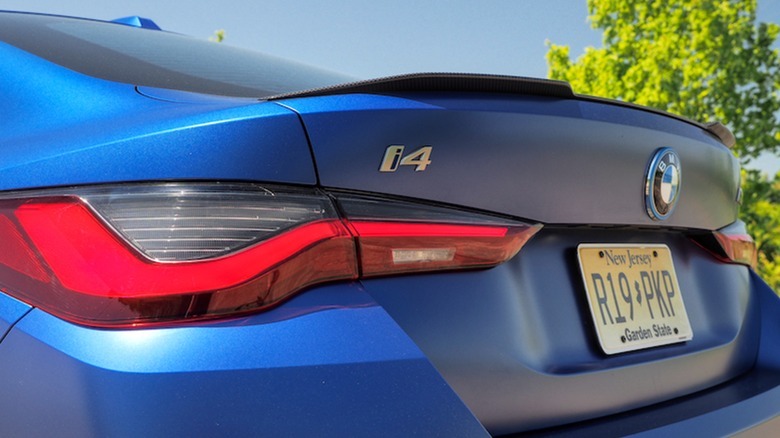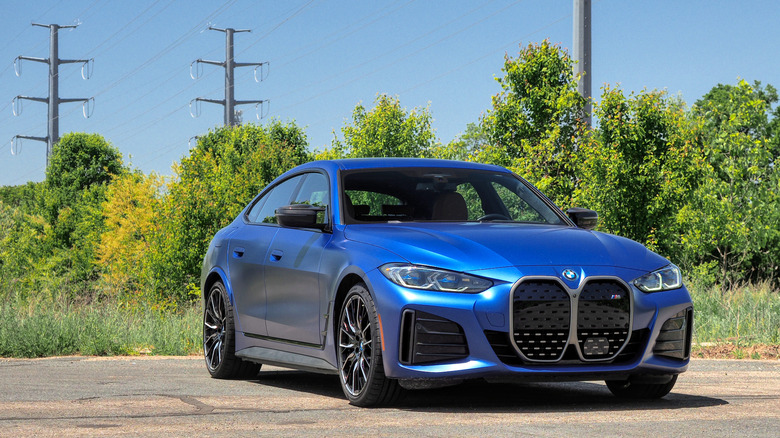BMW i4 M50 Review: Just The One M Downside
- Sleek styling doesn't sacrifice practicality
- Dual-motor drivetrain is potent and fast
- Cabin is familiar and high-tech
- Decent range, albeit with an M-car sacrifice
- Expensive when you add options
- Still can't go as far on a charge as a Model 3
For a while, BMW's strategy to electrification felt oddly divided. On the one hand, it's i Series — like the i3 and i8 — chased outlandish styling, futuristic materials, and unusual drivetrains. At the same time, BMW's plug-in hybrids masqueraded convincingly as their internal combustion cousins, hiding their EV nature as though the automaker wasn't quite convinced its mainstream owners were ready for such things.
With the BMW i4, the two strategies have collided. The electric 4 Series doesn't particularly mask its all-electric drivetrain, though it's not as avant-garde as the i3 or i8. Instead it treats its EV-ness as a means to an end: It's a sleek touring sedan that ousts gas engines in favor of the Jekyll and Hyde duality that twin e-motors brings.
For now, the rest of the 4 Series — including the capable M440i in Coupe, Gran Coupe, and Convertible forms — remains. You don't have to go all-electric, then. It's just that, after spending a week in the potent i4 M50, I'm struggling to find a particularly good reason why you shouldn't.
Three models, and an expensive options list
BMW has three versions of the i4, currently. Most affordable is the 2023 i4 eDrive35, from $52,000 (plus $995 destination), with a single electric motor, 282 horsepower and 295 pound-feet of torque, and a 5.8 second 0-60 mph time. The i4 eDrive40 starts at $57,100 (plus destination) and coaxes 335 horsepower and 317 pound-feet of torque out of its single motor, trimming the 0-60 time to 5.5 seconds.
Then there's the i4 M50. It starts at $68,700 (plus destination), and adds a second electric motor for all-wheel drive. Altogether, there's 536 horsepower and 586 pound-feet of torque, while the 0-60 time is trimmed to 3.7 seconds.
As always, BMW's options list is extensive and potentially expensive. The matte Frozen Portimao Blue paint is $3,600; BMW's High Performance Package with the handsome 20-inch M wheels is another $2,500. The M Carbon Exterior Package is $2,800.
Those extras add up
The same goes for the interior. As standard, the i4 M50 has BMW's Live Cockpit Plus infotainment system, with a curved display and iDrive 8.0, Apple CarPlay and Android Auto support, perforated SensaTec upholstery, a power glass moonroof, navigation, and multi-zone climate control.
The Premium Package ($950) adds a heated steering wheel and heated front seats, lumbar support, and ambient lighting. The Parking Assistance Package ($700) adds Parking Assistant Plus, Drive Recorder, parking sensors, and a 360-degree camera.
Then there's the $1,700 Drivers Assistance Pro Package, with Extended Traffic Jam Assistant and Active Driving Assistant Pro. In congested highway traffic, the i4 will take care of steering and speed without the driver having their hands on the wheel, albeit only up to speeds of 40 mph. An attention-monitoring camera makes sure you're still watching the road, and when traffic eases, you'll need to take back over, unlike, say, GM's Super Cruise.
The fancier Icon Adaptive LED LaserLight headlamps are $1,000, a wireless phone charger is $200, an embedded 5G modem with eSIM is $300, and the Harman Kardon audio system is $875. The curved display and head-up display are $1,000, and then $300 caps things off with some carbon fiber trim.
All-in, this particular car tops out at $82K. That's within a few thousand dollars of the upcoming BMW i5 M60, which starts at $85,750 (plus destination). It'll have more power — at 590 horsepower — but, being bigger, the same 3.7 second 0-60 mph time.
Just who are we competing with, here?
Really, though, it's tough to find a direct competitor for the BMW i4 M50. Or, at least, one which fits into every slice of the Venn diagram the German performance EV sketches out. On a speed basis, the most obvious is Tesla's Model 3 Performance (from $53,240 plus destination), which bests the Beemer with a 3.1 second 0-60 mph time.
Few would argue that the Tesla badge has the same cachet as the BMW roundel, nor that the styling is as aggressive. The Model 3's interior doesn't hold up to the i4's either, though the Tesla is definitely cheaper.
You could say the same for the Kia EV6 GT, from $61,600 (plus destination). It brings 576 horsepower to the party, and Kia says it'll do 0-60 mph in 3.4 seconds. Once again, though, it lacks the cachet and the refined cabin of the BMW. I'm not entirely sure i4 M50 owners or prospective buyers will be cross-shopping at their local Kia dealership.
It feels like a BMW
Neither, really, should they be. The i4 M50 does exactly what you'd hope for from a BMW electric sedan: it feels like a BMW, that happens to be electric. The dashboard feels much the same as you'd expect from a 4 Series, and the controls are familiar. Trim, fit, and finish are all excellent, and the seats are both comfortable and supportive. Headroom in the rear is a little snug — not a surprise given the i4 is billed as a "Gran Coupe" rather than a traditional sedan.
BMW's iDrive 8.0 is both capable and complex. It certainly looks great on the big, curved array of dual displays, and the touchscreen is slickly responsive; I didn't reach for the physical control wheel once. There's definitely a lot of potential for tweaking and plenty of menus, though, which can be a little intimidating until you're familiarized with it.
Thankfully — and unlike more potent versions in the M family, which break out the options into a dizzying array of potential combinations — the drive mode situation is straightforward. Buttons for Sport, Comfort, and Eco Pro are on the center console; in Sport mode, there's a Sport Boost option that unlocks maximum performance along with an "M-specific soundscape."
Fast, though not excessively so
The result feels fast, though not face-meltingly so. The i4 M50 accelerates with confidence, that now-familiar rush of instantaneous torque not giving way until you're well into license-losing speeds. The steering is well-weighted, with a variable-ratio in the M50.
Adaptive suspension is fitted as standard, and it's a key part of the EV's charm. In Sport mode, it leaves things firm but without being unduly harsh. Corners are handled with poise, and it's not hard to imagine how the i4 M50 could capably deal with more power should BMW prove so inclined. Is an M3 slightly more engaging, with a little more feedback through the wheel? Probably, yes, but the i4's low center of gravity and all-wheel drive leave it feeling like an electric scalpel rather than an analog one.
Switch over to Comfort mode, meanwhile, and those trick dampers leave the whole thing feeling much more compliant. Then it's the sense of hush and refinement which stand out, the i4 M50 susurrating through traffic with a grace familiar from BMW's much larger luxury sedans. Comfort and Eco Pro modes also tone down the artificial noise, too, which the automaker says is generated dynamically depending on how you're driving in Sport mode. That may well be the case, but I'm still not sure I like the resulting sound any more for it.
Range takes an M50 hit
With two motors and a focus on pace, you lose range compared to the rear-wheel drive i4 cars. They're EPA rated at up to 301 miles (wheel-size depending), whereas the i4 M50 on 20-inch wheels sees that drop to just 227 miles. Given the same car on the standard 19-inch wheels is rated at 271 miles, I think I'd bite the bullet and pick range over aesthetics.
With 200 kW DC fast charging support, BMW says you could see up to 97 miles of range added after 10 minutes plugged in. That's not the fastest charging we've seen, but nor is it the slowest. BMW doesn't have its own public charging network, but i4 buyers get two years of free, 30 minute Electrify America charging sessions.
As for regenerative braking, there's a choice of three levels — High, Mid, and Low — accessed through the i4's settings. An Adaptive mode sees the rate of regen (the speed at which the EV slows when you lift off the accelerator pedal) adjust according to the current road conditions: more aggressive if you're in traffic, less so if you're cruising on the highway.
In theory that's exactly what you want, but the fact that it all happens in the background left me second-guessing just what would happen each time. Switching from "D" into "B" mode summons the most aggressive regen, allowing for one-pedal driving.
BMW i4 M50 Verdict
For a performance car, the BMW i4 M50 is oddly practical. It's adult-scale in both the front seats and the rear, despite the swooping styling. The hatchback trunk is far easier to unload than a sedan would be, not to mention reasonably sized at 10 cubic-feet. In Comfort mode, it'll sashay in pleasing hush, every bit the German luxury four-door we've come to expect from the automaker.
Tap the Sport button, though, and things get feistier. It's heavier than an M440i, yes, but the i4 M50 is also more powerful and it feels more urgent. BMW doesn't hide the ways to turn off the traction control — if you're so inclined — but even with the electronics all active, this is playful and punchy car that handles neatly. The only real downside is the M50's hit on overall range, though the speedy charging helps offset that struggle.
What it doesn't require is stepping too far outside of the familiar BMW experience, which in this case feels like a good thing. The automaker's earlier attempts at electrification, the i3 and i8, were striking and charming in their own ways, but also felt distinctively separate from everything else in the lineup. The BMW i4 M50 doesn't take anywhere near as much explanation, and the result is all the more rewarding for it.
